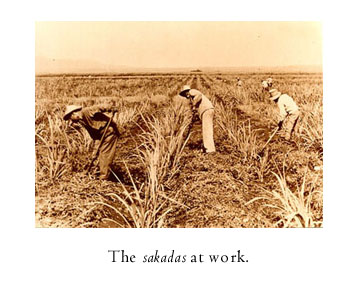Plantation
Life
 A
1919 report by a Philippine investigator, Prudencio
Remigio, tasked to investigate plantation conditions
stated that the Filipino sakadas complained of
inadequate wages, poor housing, abusive plantation foreman
or luna, strict plantation police, and general
isolation. Plantation work was extremely difficult since
it involved planting, hoeing, and carrying sugar cane.
The Ilocanos were not used to this rigid, punishing
working schedule. In Ilocos, they did not have to work
as many hours and were not subject to a strict system,
where the luna went around with a black whip
and forced them to work strenuously for so many hours.
The luna was backed by a police force capable
of breaking down workers' resistance. A
1919 report by a Philippine investigator, Prudencio
Remigio, tasked to investigate plantation conditions
stated that the Filipino sakadas complained of
inadequate wages, poor housing, abusive plantation foreman
or luna, strict plantation police, and general
isolation. Plantation work was extremely difficult since
it involved planting, hoeing, and carrying sugar cane.
The Ilocanos were not used to this rigid, punishing
working schedule. In Ilocos, they did not have to work
as many hours and were not subject to a strict system,
where the luna went around with a black whip
and forced them to work strenuously for so many hours.
The luna was backed by a police force capable
of breaking down workers' resistance.
The
HSPA adopted a "divide-and
-rule" policy whereby workers of different ethnicity
were pitted against each other for the purpose of keeping
wages down. In cases of strikes, one ethnic group would
be used as scab labor to break the strike of another
ethnic group. Living arrangements, job assignments,
and wages were also based on ethnicity. Caucasians were
higher paid, considered skilled workers, and assigned
supervisory positions. The lowest paid white worker
was the plantation police who earned $140 a month. In
contrast, the Japanese and the Filipinos were assigned
the backbreaking work in the fields. They worked at
least 10 hours a day, six days a week, 27 days a month
for 90 cents a day or $20/month.
Response
of Workers in Hawaii
In
his study of Hawaii plantations, Ronald Takaki states
that the workers’ response was resistance which
took several forms. Workers resorted to violence like
committing arson and assaulting the luna. A subtle
form of response was recalcitrance such as work slowdown,
intentional laziness, and inefficiency. Workers took
turns serving as lookouts for the luna while
the rest stopped working, smoked, and "talked story".
But Takaki notes that due to excessive fear among workers,
recalcitrance was not flaunted.
Strike
was another response of the workers. In 1909 Oahu witnessed
the Great Strike by Japanese laborers who demanded higher
wages and an end to the discriminatory wage differential
based on ethnicity. To counter the strike, Filipinos
were recruited to replace the vacated jobs. This marked
the first massive immigration of Filipinos to Hawaii.
In 1920 a larger, more organized strike occurred on
Oahu, this time by Japanese and Filipino laborers demanding
a wage hike and a change in the bonus system. The strike
ended after a six month standoff by which time the workers
received some concessions such as increased wages, abolishment
of wage differentials, and changes in the bonus system.
Takaki claims that the biggest gain in these strikes
was the realization that "blood unionism",
i.e., organizing workers into unions on the basis of
ethnicity, had to be replaced by a larger, class-based
solidarity as was displayed by the inter-ethnic alliance
of the Japanese and Filipino laborers.
The
Filipinos were organized as a result of the efforts
of two Filipino labor leaders: Pablo
Manlapit and Carl
Damaso. In her study of Manlapit, Melinda Tria Kerkvliet
claims that his leadership was displayed in the 1920
and 1924 strikes. In the 1920 strike, Manlapit believed
that the Japanese and the Filipinos should be united.
After the two month strike ended, Manlapit became the
subject of a smear campaign by the sugar planters and
he was accused of extorting money in exchange for calling
off the strike. But it was the 1924 strike which proved
fatal for Manlapit’s career. The strike had a tragic
ending when the police and strikers clashed in Hanapepe,
Kauai, resulting in the death of 20 people. Since Manlapit
was at the forefront of the strike, sugar planters hounded
him by filing various charges such as failure to provide
adequate water closets (toilets) for the evicted strikers
who were lodged temporarily in Kalihi. A conspiracy
charge was filed against him after he was said to have
coached a striker, Pantaleon Enayuda, to falsely claim
that his (Enayuda’s) sick baby died after the Oahu
Sugar Company, which managed the Waipahu hospital, ordered
the removal of the baby. Manlapit was found guilty of
libel and Enayuda turned witness against Manlapit for
the conspiracy case. Manlapit was imprisoned and later
deported from the islands.
Another
prominent Filipino labor leader was Carl Damaso who
came to Hawaii as a seventeen year old worker during
the height of the depression in the 1930s. In 1934,
he joined a strike of his fellow Filipino workers at
Ola’a Sugar Plantation - also known as Puna Sugar
Company - in the Big Island. The Filipinos, who made
up 70% of the plantation workforce, protested the lowering
of wages and the employment discrimination policy. The
strike was defeated and Damaso was branded a labor agitator
and placed on the list of "do not hire". He
moved to Maui and found work at the Wailuku Sugar Company
but was soon fired for attempting to start a union.
It was after World War II that he became a prominent
labor leader when he organized the International Longshoremen’s
and Warehousemen’s Union (ILWU).
|

